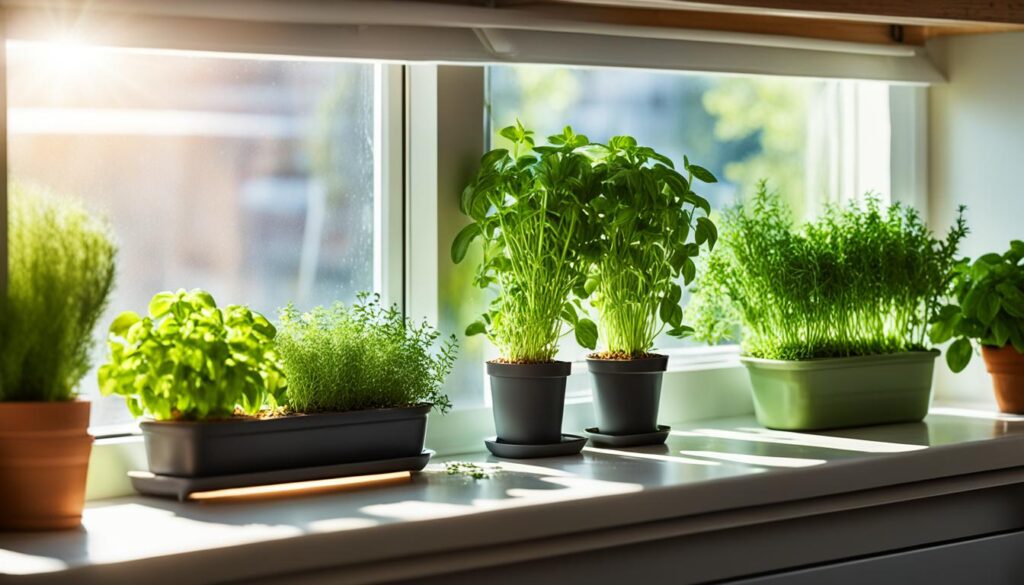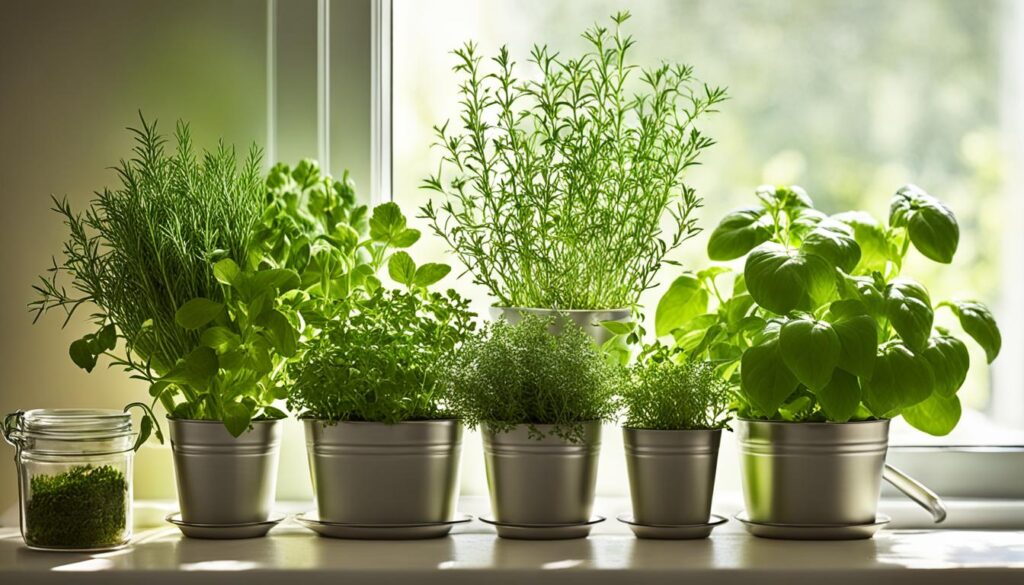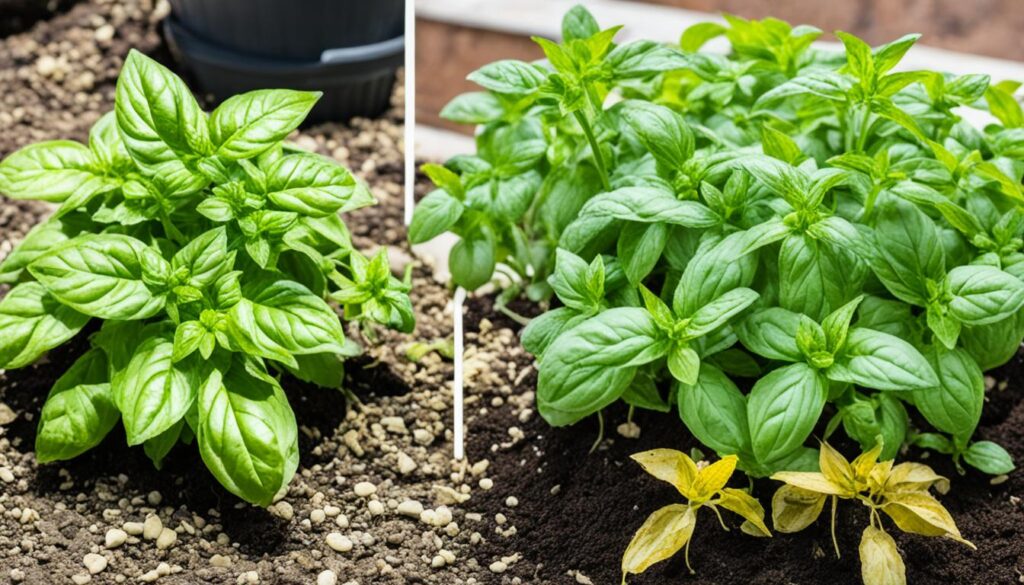Top 10 Easiest Herbs to Grow Indoors for Fresh Cooking
Ever dreamt of having a fresh herb garden right in your kitchen? Discover the easiest herbs you can grow indoors to elevate your cooking and add a touch of green to your home! Tossing fresh basil into pasta sauce, adding cilantro to guacamole, or dropping mint into a mojito is special. But, nothing beats the taste of home-grown herbs.
If you don’t have outdoor space or live where the winters kill off herbs, don’t worry. You can still enjoy fresh herbs indoors. Just pick herbs that grow well inside and give them the right light and water. Try planting a few of these 10 easiest herbs to grow indoors. See how they make your meals more flavorful.
Key Takeaways
- Discover the top 10 easiest herbs to grow indoors for fresh cooking
- Learn the benefits of growing an indoor herb garden
- Get essential tips on light requirements, watering, soil, and more for indoor herb gardening
- Explore common problems and solutions for growing herbs indoors
- Discover how to harvest and use your homegrown herbs to elevate your meals
Introduction
Growing an indoor herb garden is fun and rewarding. It lets you have fresh, tasty herbs all year. It’s great for both experts and beginners. With the right care, you can make your own best indoor herbs garden at home.
Indoor herb gardens are versatile and open up many cooking possibilities. Just think about having fresh herbs like basil and oregano ready for your meals. It’s a joy to add these to your dishes.
We’ll talk about why growing herbs indoors is good and give tips for a great indoor herb garden. Knowing what herbs need for light, water, and soil will help you grow your own herbs at home.
“Herbs are the friends of the physician and the pride of cooks.” – Charlemagne
If you love cooking or are just starting, this guide is for you. It’s your first step into the exciting world of easy herbs to grow and best indoor herbs.
Benefits of Growing Herbs Indoors
Growing your own herbs indoors is a great hobby with many advantages. It’s perfect for both seasoned cooks and those looking to improve their cooking. The benefits of indoor herb gardening are clear and appealing.
Having fresh, flavorful herbs right at your fingertips is a big plus. You can easily add basil to your pasta sauce or rosemary to your roasted veggies. This means you can enjoy new flavors all year, making your cooking better.
Indoor herb gardens are great even when outdoor gardening isn’t possible. You can enjoy summer flavors all year, no matter the weather. This lets you add fresh herbs to your meals often, making your dishes more vibrant.
Looking after an indoor herb garden is also a fulfilling hobby. It connects you with nature and can be calming. Caring for your plants and watching them grow is a great way to relax and reduce stress.
| Benefits of Indoor Herb Gardening | Advantages of Growing Herbs Indoors | Reasons to Grow Herbs Indoors |
|---|---|---|
| Fresh, flavorful herbs available year-round | Enjoy herbs even in cold climates | Convenient access to herbs for cooking |
| Ability to experiment with new flavors | Rewarding hobby that connects you to nature | Opportunity to grow herbs without outdoor space |
| Therapeutic and calming experience | No need to venture outside to harvest | Year-round supply of fresh, flavorful herbs |
In conclusion, growing herbs indoors has many benefits. It offers convenience, joy, and a chance to connect with nature. It’s a rewarding hobby for cooks and plant lovers alike.
Essential Tips for Growing Herbs Indoors
To grow a successful indoor herb garden, pay attention to a few key factors. Knowing what your indoor herb plants need ensures they thrive. This way, you get a constant supply of fresh, flavorful ingredients for cooking.
Light Requirements
Proper lighting is key for indoor herbs. Most herbs need at least 6 hours of direct sunlight daily. Place your plants near a south-facing window for best light.
If sunlight is scarce, use grow lights to help. This ensures your indoor herbs get enough light.
Watering Guidelines
Keeping the right moisture balance is vital for healthy herbs. Don’t overwater, as it can cause root rot. Let the soil dry out a bit between waterings.
Check the soil often and water when it feels dry on top. Adjust your watering based on temperature and humidity.
Soil and Potting
Use a well-draining potting mix for indoor herbs. This soil type gives the right nutrients and drainage. Choose containers with drainage holes to prevent waterlogging.
Consider self-watering planters or adding pebbles to your pots for better drainage.
Temperature and Humidity
Herbs do well in moderate temperatures, between 65°F and 75°F. Keep your grow space at these temperatures. Avoid extreme heat or cold.
Most indoor herbs prefer average humidity levels. They don’t need high humidity to grow well.

Follow these tips for growing herbs indoors. You’ll have a thriving, easy-to-maintain indoor herb garden. This garden will give you fresh, flavorful ingredients for your cooking.
Top 10 Easiest Herbs to Grow Indoors
Starting an indoor herb garden is easy with the right plants. From basil to rosemary, many herbs that thrive indoors are perfect for adding flavor to your meals. Here are the top 10 easiest herbs to grow indoors.
Basil
Basil is a key herb for cooking that loves warm, sunny spots. It grows well indoors if it gets at least 6 hours of sunlight daily. Make sure it has good drainage and regular watering.
Mint
Mint grows quickly and does well in pots. It likes partial shade and stays happy in moist soil. This makes it a great pick for an indoor herb garden.
Parsley
Parsley is tough and easy to care for, needing lots of sunlight. It’s perfect for new indoor herb growers because it’s easy to look after and grows in many conditions.
Chives
Chives are versatile and easy to grow indoors. They love sunny spots and soil that drains well. Adding them to your indoor herb garden is a smart move.
Thyme
Thyme is a tough herb that excels in containers and indoors. It needs plenty of sunlight and soil that drains well. Once it’s set up, thyme is easy to keep and gives you fresh leaves for cooking.
Oregano
Oregano is a robust, tasty herb that fits well indoors. It likes lots of sunlight and soil that drains well. It’s a top pick for best herbs for indoor growing.
Cilantro
Cilantro grows quickly and does well indoors. It thrives in bright, sunny places and needs regular watering to keep its flavor.
Rosemary
Rosemary is versatile and can handle indoor conditions. It prefers soil that drains well and lots of sunlight. It’s a great choice for easiest herbs to grow indoors.
Sage
Sage is fragrant and tough, perfect for indoor growing. It needs plenty of sunlight and soil that drains well. With proper care, sage becomes a dependable part of your indoor herb garden.
Dill
Dill is a tasty herb that grows indoors with some extra care. It likes full sun and soil that drains well. Remember to keep it watered to avoid bitter leaves.
Adding these herbs that thrive indoors to your indoor garden means you’ll have fresh, fragrant ingredients for cooking all year.

Common Problems and Solutions
Growing an indoor herb garden can be rewarding and tasty, but it has its challenges. As you start growing herbs indoors, know the common issues you might face and how to fix them. By understanding these problems and using the right care tips, you can keep your indoor herb garden healthy and fragrant.
Overwatering and Root Rot
Overwatering is a big problem for indoor herbs, leading to root rot. To prevent this, let the soil dry out a bit between waterings. Check the soil often and adjust how often you water your plants.
Pest Infestations
Herbs inside can get pests like aphids or spider mites. These pests can harm your plants fast. To fight this, use insecticidal soap or neem oil to get rid of them safely.
Insufficient Sunlight
Not enough sunlight is another big issue for indoor herbs. They need bright, direct light to stay healthy and tasty. Make sure your herb garden gets enough sunlight or use a grow light if needed.
By solving these common problems and using the right solutions, you can keep your indoor herb garden healthy and full of fresh herbs. This way, you’ll always have what you need for your cooking.

Harvesting and Using Your Herbs
One of the best parts of growing harvesting fresh herbs indoors is being able to take fresh leaves or sprigs as you need them. For most herbs, just cut above a set of healthy leaves. This lets the plant keep growing. Don’t take more than a third of the plant at once.
Beyond just using homegrown herbs in cooking, you can dry or freeze them for later. Drying keeps their flavor, while freezing keeps both flavor and color. With your own indoor herb garden, you’ll enjoy homegrown goodness all year.
For herbs like mint, basil, cilantro, and dill, harvest often to keep them bushy. When harvesting oregano, parsley, sage, and thyme, pick long stems with a few leaves. Snip chives about an inch above the soil. Never take more than a third of your greens at once. With the right harvesting, your indoor herbs will thrive and be ready for your cooking.
FAQ
What are the benefits of growing herbs indoors?
What are the essential tips for growing herbs indoors?
What are the best herbs to grow indoors?
What common problems might I encounter when growing herbs indoors?
How do I harvest and use my homegrown indoor herbs?
- 10 Must-Have Blooms for Your 2025 Garden
- The Health Advantages of Gardening You Need to Know
- How to Create a Small Vegetable Garden Layout Plan: A Beginner’s Guide
- DIY Garden Projects for Small Spaces: Upcycling Ideas to Maximize Your Garden
- Watering Techniques for Small Gardens: Ensuring Your Plants Thrive
- Small Border Plants for Landscaping: Adding Beauty and Functionality to Your Garden
- Year-Round Small Space Gardening: Seasonal Planting Tips for Maximum Harvest
- Essential Tools for Small-Space Gardening: What You Really Need
- The Ultimate Guide to Container Vegetables: What to Grow in Small Spaces
- Budget-Friendly Gardening: How to Create a Thriving Garden on a Tight Budget
- How to Optimize Sunlight in Small Gardens: Tips for Better Plant Growth
- DIY Vertical Planters: Creative Ideas for Small Space Gardening
- Companion Planting for Small Vegetable Gardens: Boost Growth and Deter Pests
- Container Gardening Essentials: Choosing the Right Pots, Soil, and Plants
- Vertical Gardening Techniques: Maximizing Your Small Space with Climbers and Vines
- How to Build a Raised Bed Garden in a Small Backyard: Step-by-Step Guide
- The Best Vegetables for Small-Space Gardens: High-Yield Varieties You Need to Grow
- Smart Vegetable Garden Layouts for Small Spaces: Maximizing Your Green Thumb in Compact Areas
- 40. Best Practices for Managing a Sustainable Garden Year-Round
- Building a Wildlife Pond for Biodiversity
- Advanced Techniques in Sustainable Gardening
- How to Create a No-Till Garden
- The Mental Health Benefits of Gardening
- Using Technology to Enhance Sustainable Gardening
- Getting Certified Organic: Steps and Benefits

Leave a Reply